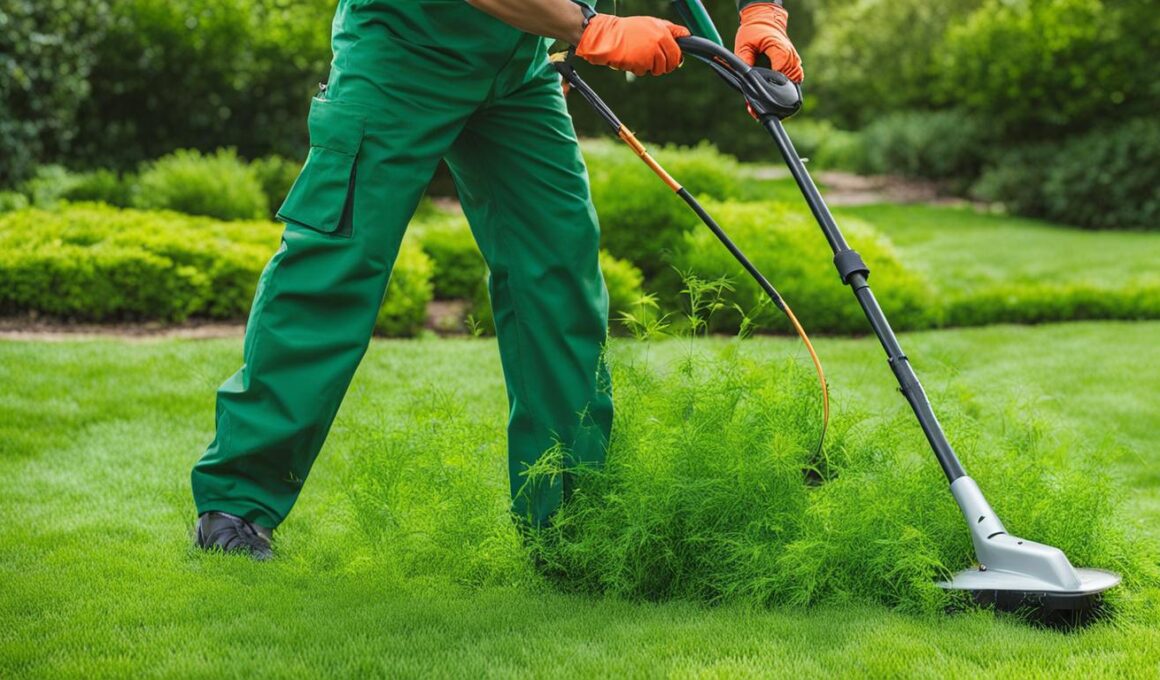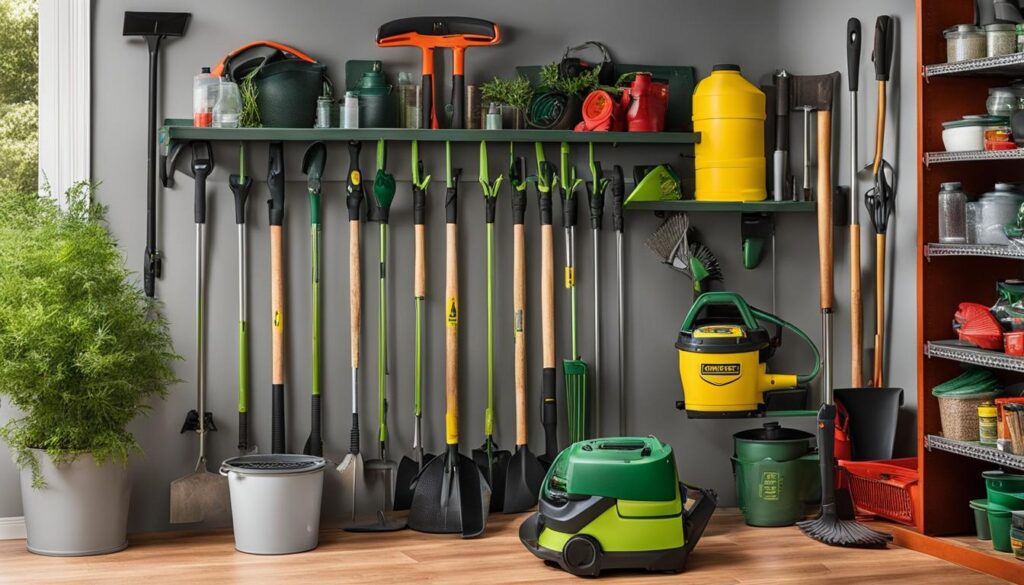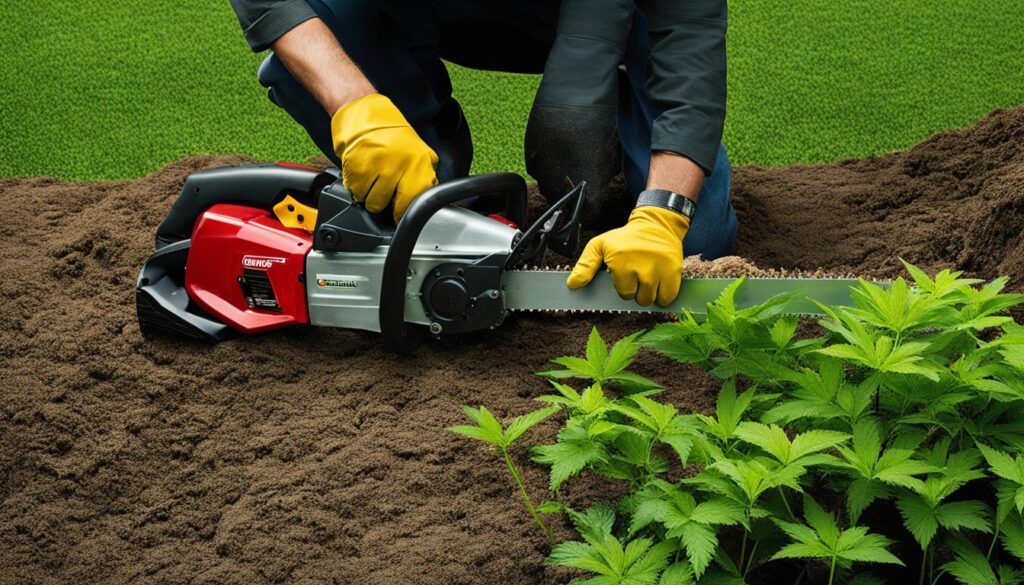Welcome to our easy guide on how to use a weed eater efficiently. If you’re looking to maintain a pristine lawn, knowing how to use a weed eater correctly is essential. In this guide, we’ll provide you with step-by-step instructions for using a weed eater effectively, so you can achieve professional-looking results.
Whether you’re a beginner or have some experience with weed eating, these tips will help you make the most out of your tool. From safety precautions to proper techniques, we’ll cover everything you need to know to become a weed eating pro.
Ready to get started? Let’s dive in and explore the world of efficient weed eater use!
Safety First: Gear Up and Prep
Before using a weed eater, it’s important to prioritize weed eater safety. Protecting yourself from potential injuries is crucial in ensuring a safe and productive experience. Take the necessary steps to prepare and gear up before operating your weed eater.
Protective Gear for Weed Eater
When using a weed eater, always wear the appropriate protective gear to safeguard yourself from any potential accidents. Put on safety glasses to shield your eyes from debris or flying objects. Wear gloves to protect your hands and to provide a better grip on the equipment. Sturdy shoes are essential to shield your feet from any hazards on the ground. Donning long-sleeved clothing will help prevent any scratches or cuts to your arms.
Preparing to Use Weed Eater
Prior to use, it’s essential to prepare the area and remove any small- to medium-sized objects that may pose a risk to the nylon cutting wire. These objects can cause damage to the weed eater or become dangerous projectiles. Clear the area of any obstructions such as rocks, branches, or toys before starting your weed eater.
For electric weed eaters, always be mindful of the power cable. Ensure it is positioned behind you to avoid accidentally cutting the cable during operation. Take the time to check for any damage or fraying in the cable before use. A damaged cable should be replaced to prevent electrical hazards.
Starting and Storing the Weed Eater
Now that you’re geared up and ready to go, it’s time to start your weed eater and get to work. The process may vary depending on whether you have a gas-powered weed eater or an electric one.
Starting a Gas-Powered Weed Eater
To start a gas-powered weed eater, follow these steps:
- Prime the engine bulb by pressing it three to four times. This helps to draw fuel into the carburetor and makes starting easier.
- Pull the starter cord firmly and quickly to ignite the engine. It may take a few tries to get it going.
- Adjust the choke according to the instructions provided with your weed eater. The choke helps regulate the air-to-fuel mixture, especially when starting a cold engine.
Remember to consult your user manual for specific instructions on starting your gas-powered weed eater.
Starting an Electric Weed Eater
Starting an electric weed eater is much simpler. Just follow these steps:
- Ensure the weed eater is plugged in or fully charged, depending on the model.
- Locate the trigger and safety switch on the handle.
- Pull the trigger and safety switch simultaneously to start the engine. Release them to stop.
Electric weed eaters are known for their convenience and ease of use. They eliminate the need for gas and oil, making them a popular choice among homeowners.
Once you’re done using the weed eater, it’s important to store it properly to ensure its longevity.
Storing Your Weed Eater
Follow these tips when storing your weed eater:
- Allow the engine to cool down completely before storing.
- Remove any trimmer line or attachments and clean off any debris.
- Find a safe and dry location to store the weed eater, away from children and pets.
- If you have a gas-powered weed eater and don’t plan on using it for more than a month, it’s recommended to drain the engine of any remaining fuel.
By properly starting and storing your weed eater, you’ll maximize its performance and ensure its longevity for years to come.
How to Properly Hold the Weed Eater
To ensure optimal control and comfort while using a weed eater, it’s essential to know how to hold it correctly. By following these guidelines, you’ll be able to maintain control of the weed eater and achieve precise results.
1. Grip Placement
Hold the weed eater with one hand on the trigger and the other on the handle. This grip allows you to control the machine effectively and adjust the speed as needed.
2. Positioning
Keep the weed eater at waist level for a comfortable working posture. This position provides better maneuverability and reduces strain on your back and arms.
3. Cutting Technique
Utilize a steady side-to-side motion while slowly walking forward to cut with the weed eater. This technique ensures even trimming and prevents an uneven appearance on your lawn.
4. Shoulder Strap
If your weed eater comes with a shoulder strap, use it to distribute the weight evenly across your body. The strap reduces strain on your arms and allows for extended periods of comfortable use.
By holding the weed eater properly, you’ll not only maintain control over the machine but also improve your overall experience. With these techniques, you’ll be able to achieve precise cuts and maintain a well-groomed lawn with ease.
Trimming Techniques: Cutting Grass and Weeds
When it comes to using a weed eater to trim grass and weeds, the right techniques can make all the difference in achieving a well-groomed lawn. Here are some essential tips to help you get the job done efficiently:
1. Hold the line parallel to the ground: When using a weed eater, hold the nylon cutting line parallel to the ground. This will ensure that the line makes contact with the grass or weeds, resulting in effective cutting.
2. Move in a back-and-forth motion: To achieve even and consistent trimming, move the weed eater in a back-and-forth motion. This will help you achieve clean and precise cuts.
3. Cut with the tip of the nylon wire: For the best cutting results, aim to cut with the tip of the nylon wire. This will optimize the cutting power and prevent unnecessary wear and tear on the line.
4. Be cautious when trimming around trees and flower beds: When trimming around trees and flower beds, maintain a safe distance to avoid damaging the bark or plants. Take your time and carefully maneuver around these areas to ensure a neat and tidy appearance.
5. Tilt the weed eater for edging: When edging along hard surfaces such as driveways or sidewalks, tilt the weed eater on its side and move it along the surface. This technique will create a clean gap between the grass or weeds and the hard surface, giving your lawn a polished look.
By implementing these trimming techniques, you’ll be able to achieve professional-looking results with your weed eater. Remember to prioritize safety, maintain proper form, and take your time to ensure a well-groomed and pristine lawn.
Choosing the Right Weed Eater
When it comes to selecting a weed eater, it’s important to consider your specific needs and the characteristics of your yard. There are different types of weed eaters available, each offering unique benefits. Let’s explore your options:
Gas-Powered Weed Eater
If you have a larger yard with dense vegetation, a gas-powered weed eater might be the right choice for you. These weed eaters are known for their power and durability, making them suitable for tackling tough jobs. They are also convenient as they don’t require an electrical outlet, giving you more freedom to move around your yard.
Electric Weed Eater
If noise levels and ease of use are a concern for you, an electric weed eater is a great option. These weed eaters are generally quieter than their gas-powered counterparts and require less maintenance. Electric weed eaters are also lighter, making them easier to handle, especially for those with physical limitations.
Straight Shaft Weed Eater
If you have bushes or other obstacles in your yard, a straight shaft weed eater is a versatile choice. The extended reach of the straight shaft allows you to reach underneath bushes and other hard-to-reach areas with ease. This type of weed eater provides better maneuverability and is ideal for larger yards with intricate landscaping.
Curved Shaft Weed Eater
For smaller yards or areas with less dense vegetation, a curved shaft weed eater may be more suitable. These weed eaters are lighter in weight and generally offer greater comfort during use. The curved shaft design allows for easier handling and maneuvering, making it ideal for homeowners with a less extensive lawn care regimen.
Take the time to assess your yard’s size, vegetation density, and specific needs to determine the best weed eater for you. Consider the gas-powered or electric options, as well as the benefits of both straight and curved shaft designs. Remember, choosing the right weed eater will ensure optimal performance and help you achieve the results you desire.
Tips for Maintaining a Weed Eater
Maintaining your weed eater is crucial for its longevity and optimal performance. By following these tips, you can ensure that your weed eater stays in top shape for years to come.
Regular Cleaning and Servicing
Regularly clean your weed eater after each use to remove debris and grass clippings. Use a brush or cloth to wipe away any dirt or residue. Additionally, follow the manufacturer’s recommendations for servicing. This may include checking and replacing spark plugs, cleaning the air filter, and lubricating moving parts. Proper cleaning and servicing will keep your weed eater running smoothly and efficiently.
Keep Spare Replacements on Hand
Accidents happen, and parts of your weed eater may wear out over time. To avoid interruptions during your tasks, keep spare replacements for accessories such as trimmer line. This way, you can quickly replace any worn-out or broken parts and continue with your weed-eating without delay.
Proper Storage
Store your weed eater in a dry place, ideally off the ground, to prevent dust and debris buildup. This will help maintain the integrity of the machine and its components. If you have a gas-powered weed eater, consider using fuel stabilizer in the gas tank when storing it for long periods. This will help prevent fuel degradation and potential engine damage.
Invest in Quality Accessories
Using the right accessories can enhance the performance of your weed eater and make your tasks easier. Consider investing in high-quality trimmer line that is suitable for your specific weed eater model. This will ensure clean and efficient cutting. Additionally, explore other accessories such as edger and brush cutter attachments, which can expand the versatility of your machine and allow you to tackle various lawn care tasks.
Follow Safety Guidelines
Lastly, always follow the safety guidelines outlined in the user manual. Wear appropriate protective gear, such as safety glasses and gloves, to protect yourself from potential injuries. Avoid using the weed eater in wet conditions or near flammable materials. By prioritizing safety, you can prevent accidents and prolong the lifespan of your weed eater.
What are the Best Techniques for Efficiently Using a Weed Eater for Perfect Edges?
When using a weed eater, there are a few tips for perfect edges. First, hold the trimmer at a slight angle to create a clean cut. Next, move the trimmer slowly to ensure precision. Finally, maintain a steady hand to avoid jagged edges. These techniques will result in neatly trimmed borders.
Conclusion
Congratulations! You now have a comprehensive understanding of how to use a weed eater efficiently. By following the safety tips, holding the weed eater correctly, and using the proper techniques, you’ll be able to achieve professional results in maintaining your lawn.
Remember to prioritize safety by wearing protective gear like safety glasses and gloves. Additionally, choose the right weed eater for your needs, whether it’s a gas-powered or electric model, and consider the type of shaft that suits your lawn size and trimming requirements.
Proper maintenance is essential for optimal performance, so make sure to clean and service your weed eater regularly. Store it in a dry place, away from the ground, to prevent dust and debris buildup. With these practices in place, you can confidently go out there and master the art of weed eating, keeping your lawn looking pristine all year round.











